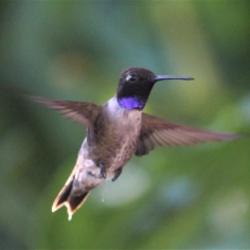The UCR Botanic Gardens is a certified National Wildlife Federation (nwf.org) Wildlife Habitat, providing shelter, water, and food sources for a myriad of reptiles, amphibians, and mammals. All of these animals are important to the Gardens’ ecosystem, which also provides a habitat corridor for animals moving among protected spaces in Riverside. Please respect them and their home and do not approach or disturb them. We ask that you report any rattlesnake sightings in the Gardens to a staff member.
Reptiles and Amphibians
A number of reptiles may be observed at the Gardens. The Western fence lizard, alligator lizard and granite spiny lizard often sun themselves on ledges beside the paths. The California legless lizard, side-blotched lizard, western skink, orange-throated whiptail and western whiptail might also be seen. Other reptiles found in the Gardens include a number of nonvenomous snakes, including the California king snake, gopher snake, night snake, red racer, ringneck snake, rosy boa and western blind snake. The Gardens is also home to the venomous western diamondback rattlesnake and red diamond rattlesnake, which have been seen in all parts of the Gardens including occasionally the lawn areas. Visitors should observe all Gardens rules and keep children under close watch.
Some of the amphibians you might see include the slender salamander, Pacific tree frog, bullfrog and western toad. Insects and spiders abound at the Gardens. A specimen box of common insects, obtained from the UCR Entomology Museum, is displayed in the window of the entrance Gatehouse.
Mammals
Mammals found within the Gardens or seen passing through include the Audubon cottontail, California ground squirrel, Botta’s pocket gopher, coyote, gray fox, kangaroo rat, opossum, striped and spotted skunks, pack rat and other rodents. Bobcats are occasionally sighted passing through the Gardens. Most of these animals are nocturnal, so daytime visitors rarely glimpse them since they are most likely to be seen early or late in the day during a visit to the Gardens.
Birds
UCR and the UCR Botanic Gardens are a bird hotspot for permanent resident and migrating avifauna species. Nearly 200 different kinds of birds have been observed in the Gardens since its founding. Some of the more conspicuous species are the Anna's and Costa's hummingbirds, California towhee, mockingbird, raven, red-tailed hawk, roadrunner and scrub jay. Many beginning and experienced bird watchers from the UCR campus and community visit the Gardens to observe birds and record their sightings. The Gardens hosts several expert-led bird walks throughout the year; please check our calendar for an upcoming event.
Several resources are available to help you learn about and report bird sightings in the UCR Botanic Gardens. Visit the UCR Avifauna web page for a list and excellent photos of birds observed in the Gardens. The Cornell Lab of Ornithology hosts a website, eBird.org, which, once mastered, is an excellent resource for learning about birds of UCR, the Botanic Gardens, and the surrounding region. This site can be used to generate an eBird Field Checklist of all bird species observed in the Gardens, specified by season, year, or year range. These lists are a great way to guide your bird walk through the Gardens.
The UCR Bird Checklist
For an up-to-date checklist of birds of the UCR Botanic Gardens, please visit eBird.org and view data for the UC Riverside Botanic Gardens, which is a bird hotspot. Checklists for each month can be generated and used as you tour the Gardens.
A checklist of birds observed in the UCR Botanic Gardens was prepared in 1974, updated in 1985, and revised in 2000. While no longer current, this list provides valuable information on the seasonal occurrence of nearly 200 birds that have been observed over the past 50 years at the UCR Botanic Gardens and elsewhere on the campus. The four columns to the right of the species list indicate the reported seasonal occurrence and abundance of each species.

